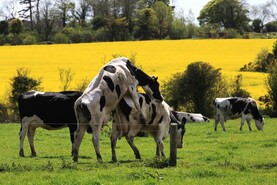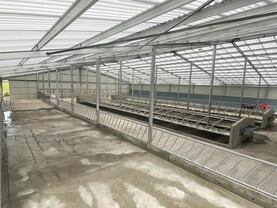Weather: The cumulative effect of all the rain over the last few weeks is really beginning to show now. Many low-lying farms and those with heavy soils are waterlogged. The only good news is that rainfall for the next seven days is forecasted to be a lot less than previous weeks. However, the difference between wet land in spring and wet land in autumn is that the ability of land to dry out in spring, with increasing daylight hours and drying winds, is much greater than in autumn.
Having said that, we are still in early autumn and there is a lot of weather to come yet before things really start to close in. A good few herds had to be housed this week. The challenge now is to get them back out to grass. Ration any remaining bits of dry land to get you through this wet period. If that means housing by night, then so be it. It’s better to have some level of grass in the diet than none at all, otherwise milk yield and protein percentage will likely fall.
For those on drier land, the challenges are considerably less. Continue on 12-hour breaks until weather picks up and watch the forecast for a window of opportunity to remove any surplus paddocks. You can expect to see growth rates drop in the next few weeks as higher covers are slow to recover from grazing and/or mowing.
Buildings: One thing the last fortnight has reminded us of is the need to be prepared for winter. Put it on the to-do list to sort out broken cubicles and mats, fix up gates, check water troughs and make sure that automatic scrapers are working correctly. Leaking gutters is one of the main causes of water getting into tanks and making them fill quicker. So too is water getting in from yards so take steps to prevent this from happening.
Recent storms have brought down a lot of trees and branches. Some farmers are asking if these can be chipped and used for animal bedding. The short answer is yes, but it depends on the type of timber. In most cases the fallen timber will need to be dried in a shed for a few months, which may not be very practical. I’m told ash timber is dry by nature and can be chipped straight away. The plan should be to put the woodchip on the base of calf pens and cover it with straw. Farmers who do this say the woodchip provides extra drainage, the straw lasts longer and less of it is used – useful for a year like this where straw could be scarce.
Fertiliser: The countdown to the end of the chemical fertiliser spreading window continues. Monday, 14 September is the last day that chemical nitrogen and phosphorus can be spread, which is less than two-and-a-half weeks away. After all the heavy rain, it’s highly likely that a significant proportion of the available nitrogen in the soil will have been leached.
There is no point in spreading any fertiliser on waterlogged soils. I think the best strategy is to wait for soils to dry out and then blanket spread as much of the farm as possible with between 20 and 30 units of nitrogen per acre before the closed period.
Read more
ICBF admit genomic inaccuracies for dairy stock
Global milk price: French lead price for big players
Weather: The cumulative effect of all the rain over the last few weeks is really beginning to show now. Many low-lying farms and those with heavy soils are waterlogged. The only good news is that rainfall for the next seven days is forecasted to be a lot less than previous weeks. However, the difference between wet land in spring and wet land in autumn is that the ability of land to dry out in spring, with increasing daylight hours and drying winds, is much greater than in autumn.
Having said that, we are still in early autumn and there is a lot of weather to come yet before things really start to close in. A good few herds had to be housed this week. The challenge now is to get them back out to grass. Ration any remaining bits of dry land to get you through this wet period. If that means housing by night, then so be it. It’s better to have some level of grass in the diet than none at all, otherwise milk yield and protein percentage will likely fall.
For those on drier land, the challenges are considerably less. Continue on 12-hour breaks until weather picks up and watch the forecast for a window of opportunity to remove any surplus paddocks. You can expect to see growth rates drop in the next few weeks as higher covers are slow to recover from grazing and/or mowing.
Buildings: One thing the last fortnight has reminded us of is the need to be prepared for winter. Put it on the to-do list to sort out broken cubicles and mats, fix up gates, check water troughs and make sure that automatic scrapers are working correctly. Leaking gutters is one of the main causes of water getting into tanks and making them fill quicker. So too is water getting in from yards so take steps to prevent this from happening.
Recent storms have brought down a lot of trees and branches. Some farmers are asking if these can be chipped and used for animal bedding. The short answer is yes, but it depends on the type of timber. In most cases the fallen timber will need to be dried in a shed for a few months, which may not be very practical. I’m told ash timber is dry by nature and can be chipped straight away. The plan should be to put the woodchip on the base of calf pens and cover it with straw. Farmers who do this say the woodchip provides extra drainage, the straw lasts longer and less of it is used – useful for a year like this where straw could be scarce.
Fertiliser: The countdown to the end of the chemical fertiliser spreading window continues. Monday, 14 September is the last day that chemical nitrogen and phosphorus can be spread, which is less than two-and-a-half weeks away. After all the heavy rain, it’s highly likely that a significant proportion of the available nitrogen in the soil will have been leached.
There is no point in spreading any fertiliser on waterlogged soils. I think the best strategy is to wait for soils to dry out and then blanket spread as much of the farm as possible with between 20 and 30 units of nitrogen per acre before the closed period.
Read more
ICBF admit genomic inaccuracies for dairy stock
Global milk price: French lead price for big players






 This is a subscriber-only article
This is a subscriber-only article










SHARING OPTIONS: